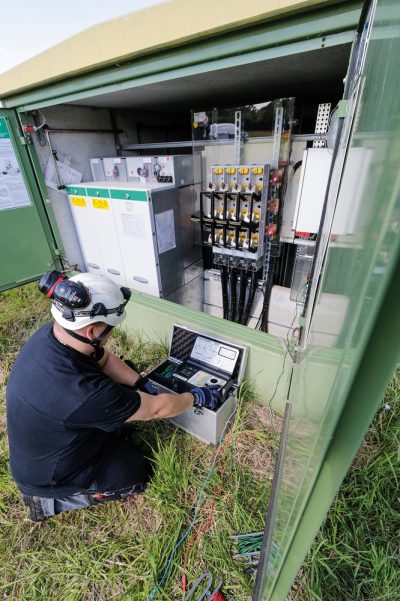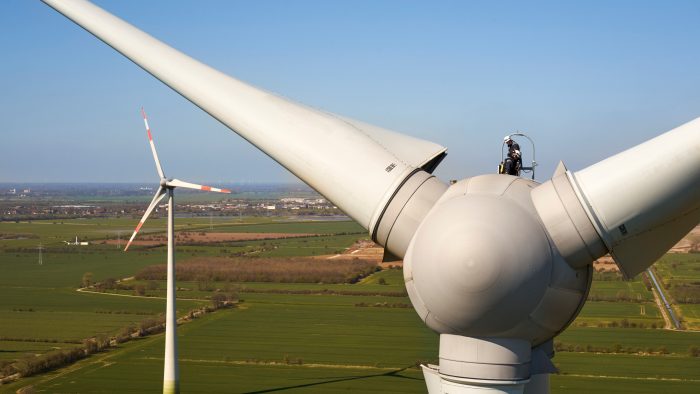WITH LOW VOLTAGE, MEDIUM VOLTAGE AND LIGHTNING PROTECTION ON THE SAFE SIDE
Electrical installations, which also include wind turbines, transfer and transformer stations, must be inspected at least every four years in accordance with DGUV Regulation 3 or in accordance with hazard analysis. Non-compliance or improper execution may result in fines or criminal prosecution for wind farm operators.
On the market there are different service providers who offer DGUV Regulation 3 inspections for wind turbines. However, many service providers do not carry out the inspection in its entirety and only a few are actually able to inspect the turbine with the specific technology of all manufacturers. When looking for a suitable supplier, wind farm operators should therefore find out exactly which areas and manufacturers the respective service provider is handling. Because we know from practice: DGUV Regulation 3 inspection is not always the same as DGUV Regulation 3 inspection.
One critical aspect, for example, is the scope of the audit. Operators should make sure that the wind farm is not only tested on the low voltage side. In addition to the low voltage, it is also necessary to check the medium voltage and the lightning protection. Medium-voltage tests include transformers, medium-voltage switchgear (including protection tests) and the testing of power cables. DGUV Regulation 3 inspection is also required by law for these components.

Technician at the DGUV Regulation 3 Inspection
Complete DGUV Regulation 3 Inspection for Wind Turbines Minimizes Costs
Often the medium voltage part and the lightning protection test are ignored due to ignorance. Especially for the medium-voltage part, specially trained electricians are required which many specialized electrician companies do not have. If only one part of the test is carried out, there is a risk of criminal prosecution and the other components of the DGUV Regulation 3 test must be ordered subsequently and carried out separately. This increases the costs for the wind farm operator as the wind farm has to be restarted and stands still again. When remedying the deficiencies found, wind farm operators should also make sure that they are carried out as quickly as possible in order to reduce yield losses to a minimum.
Testing Enercon, Vestas, Nordex & Co
In addition to the scope of the inspection, the different plant types, the plant technology and the associated requirements pose a particular challenge. Depending on the type of WTG, service providers have to consider different special requirements. With Enercon plants, for example, we benefit from the fact that we have many employees with many years of experience in the field of Enercon plant technology and therefore have the special requirements for the DGUV Regulation 3 inspection. For Vestas turbines, for example, a remote control is required to control the various units such as fans or azimuth motors. This remote control must be purchased. In all Vestas turbines from the Vestas V66 onwards, the medium-voltage transformers are installed in the nacelle. This also means special challenges for the test engineer.
In order to be able to control the various aggregates at manufacturers such as Nordex, Senvion, GE or Fuhrländer, our service technicians, on the other hand, require access levels, which they only receive through training courses given by the respective turbine manufacturer or maintenance company. Without personal access levels, which are registered for each wind farm and employee, employees cannot operate the wind turbines. Such procedures are extremely time-consuming and cost-intensive. Many providers – understandably – do not have the necessary capacities for this.
For each individual type of WTG and its individual plant technology we also have to create our own inspection procedure, since not everything can be inspected on site because certain areas are not accessible or something has to be dismantled for the inspection. Without such a standardized inspection procedure, the number of defects increases. It is therefore all the more important for a service provider to have sufficient experience and know-how in the field of different types of systems.
807 DGUV Regulation 3 Inspection in the Year 2018
As an operations manager for wind farms, wpd windmanager takes over the complete DGUV Regulation 3 inspection for wind turbines with low voltage, medium voltage and lightning protection – both for wind farm operators as well as for other operators of wind farms. Thanks to our heterogeneous portfolio of over 2,000 wind turbines and over 50 different turbine types, we have extensive experience with the requirements and turbine technology of all manufacturers. In 2018 alone, our service engineers carried out 807 DGUV Regulation 3 inspections across manufacturers. In addition, our own field service eliminates detected defects. If required, we also offer, for example, torque checks for Vestas turbines at the lower tower flange, which means that no additional network shutdowns are required and costs are saved.
